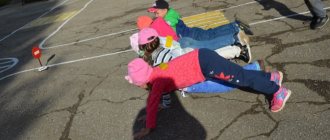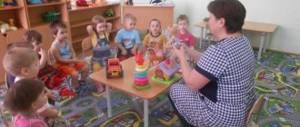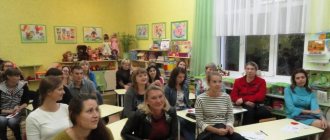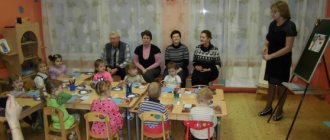A teacher of a preschool educational institution must develop an interest in reading fiction in preschool children through games, illustrations and a variety of expressive means and literary genres. In addition, the teacher’s task is to develop monologue and dialogic speech of preschoolers, their socialization and preparation for school. To achieve these goals and objectives, it is necessary to properly plan each lesson.
- 2 Motivating preschoolers in the classroom
- 3 Lesson structure
3.1 Topic index
Goals and objectives of the teacher in classes on reading fiction
The educator faces important tasks: the upbringing, training and development of children. Fiction is the best assistant in solving problems. Each specific lesson should:
- train attention and memory;
- develop thinking and speech;
- cultivate interest in intellectual pursuits.
In addition, all the works of art studied are focused on different aspects of a child’s life. The most important for children of the preparatory group are:
- moral education;
- speech development;
- artistic and aesthetic development;
- social and communicative development;
- development of independence, self-service.
For example, the fairy tale “Little Khavroshechka” belongs to the field of moral education. The specific goal of the lesson may sound like this: “Cultivate a kind attitude towards each other.” The Russian folk tale “At the Command of the Pike” refers to the development of independence. By studying it, the educator can set himself the goal of “Explaining the importance of human labor.” Social and communicative development occurs when reading the work of D. N. Mamin-Sibiryak “Medvedko”, the purpose of the lesson on this fairy tale is to introduce the world around us, the planet.
Reading in the pre-school group is given special attention
Reading fiction, discussion, situational conversation - this is how the goals set in the classroom are realized. The teacher does not explain the meaning of the fairy tale immediately after reading it - he gives the children the opportunity to figure it out on their own, helps the children see and understand the problem described, for example, through conversation.
Using a question-and-answer form of communication is the optimal way to develop verbal thinking in preschoolers.
For example, when studying the fairy tale “Geese and Swans”, you can include the following questions in the conversation:
- Who is the story about?
- Where are mother and father going?
- What does a mother ask her daughter to do?
- How did your daughter behave after her parents left for the city?
- What happened to brother?
- Who are geese-swans?
- What decision does the girl make?
- Why didn’t the stove, apple tree and milk river want to help the girl?
- Where did the girl run?
- Who did she see in the hut?
- How did the girl manage to save her brother?
- Why do the stove, apple tree and milk river help the girl on the way back?
- Can it be that the stove, the apple tree and the milk river are talking to a girl?
- Where can we find talking animals and talking objects?
A series of questions for a conversation should be structured logically: first, simple questions (based on content), then clarifying, interpretive ("Why..."), evaluative and creative.
It is important to remember that the lesson has one goal, but several tasks.
The teacher solves the following tasks at each lesson:
- educational;
- educational;
- developing.
For example, when studying the fairy tale “The Scarlet Flower,” the following tasks must be solved. Educational: cultivate a kind attitude towards each other. Educational: introduce literature, develop coherent speech, develop listening comprehension of the text. Developmental: develop speech hearing, melodic-intonation side of speech.
Each lesson should have a unique topic and purpose; there may be a subtopic in addition to the main one. Using the example of the fairy tale “The Frog Princess,” we can determine the goal: “Develop the cognitive activity of children, teach to respect other people’s interests,” the topic “Listening to a fairy tale” and the subtopic “Obedience and self-will in a fairy tale...” (moral education). During the conversation, children should understand what obedience and self-will are, how they are expressed, what follows them, how to behave, etc. By motivating children to understand these issues on their own, the teacher will achieve his goal.
Children in the preparatory group should read not only fiction, but also scientific and educational literature
Reading in the preparatory group should be educational. The teacher, developing cognitive interest, raises a conscious reader who, during his school years, will independently motivate himself and read books with pleasure.
Motivating preschoolers in the classroom
In pedagogy, there are four types of motivation for older preschoolers:
- Gaming. It will help the child shift the focus away from the technical difficulties of the reading process. Didactic games: “Reading fables”, “The word is lost”, “Recognize the hero”.
- Helping an adult. It is based on the desire to communicate with an adult, because he will approve and show interest in joint activities. For example: take images of fairy tale characters and ask the children to help you choose or draw outfits (a sundress for a fox, a shirt for a bear).
- “Teach me.” It is based on the desire of every student to feel smart and capable. For example: if a child knows a fairy tale, tell him that you forgot the sequence of actions or do not understand the actions of the characters. This way he will be more confident in discussing the material being studied.
- "With my own hands." Internal interest in making something as a gift for yourself or for your family. Drawings, crafts, postcards - all this can be done during reading lessons, but children must voice all their actions.
As a motivating start to a lesson in reading fiction, you can use games, illustrations to a work, riddles, or a problem situation. For example, when studying the Russian folk tale “The Fox and the Jug,” the teacher can show children pictures of a fox, a jug, a river, and use elements of theatricalization and games to develop intonation (fox exclamations).
Questions for conversation:
- What is this tale about?
- How did the fox get into the jug?
- How did she talk to the jug at first?
- What words did she say?
- How did the fox start talking later?
- What words did she say?
- How does the fairy tale end?
- What kind of fox is shown in this fairy tale and where can it be seen from?
To expand and enrich the vocabulary, you need to discuss the words: greed, stupidity, kindness.
Games to develop intonation:
- Guess the intonation;
- Say it kindly;
- Say it angrily.
When studying L. N. Tolstoy’s story “The Bone,” you can also use images of the main characters, plums, elements of theatricalization, and didactic games (“Brew compote”). Issues that need to be discussed with children: honesty, fighting temptation, love for family, ability to confess, tell the truth.
Materials for the introductory stage may be different, it all depends on the interest and imagination of the teacher. For example, when studying the Brothers Grimm fairy tale “Mistress Blizzard,” children will be attracted and motivated by music. When studying the Tatar folk tale “Three Daughters,” you can use riddles (about mother, sisters, squirrel, bee) to introduce the characters and include them in active activities.
- Who is the cutest in the world? Who do children love very much? I will answer the question directly: - Our dearest... (mother).
- Who loves both me and my brother, But loves to dress up more? - Very fashionable girl - My eldest... (sister).
- From branch to branch Jumps, frolics, Agile, agile, And not a bird. (Squirrel).
- Flew over the flowers, Flew over the fields. She buzzed merrily. I picked up some nectar. And she took the prey straight to her house... (bee).
For a lesson on the fairy tale “Puss in Boots” by C. Perrault, the teacher can take a cat toy and introduce it to the children as a guest.
The appearance of such a wonderful guest at the lesson will delight the children
Perception of literature in the middle group
The perception of a work of art is understood as a process that involves active activity, embodied in internal assistance, empathy for characters, and transference of events to oneself. As a result, the child feels that he is personally involved in the events taking place.
The development of perception of works goes through several stages:
- direct perception;
- empathy with the images of the work;
- the influence of literature is available.
The book arouses interest in the child at an early age. He likes to flip through pages, listen to adults read, and look at pictures. If the necessary work is carried out, then already in the third year of life the child may be interested in the fate of the heroes.
Important! The main feature of a child’s perception of a literary work is empathy for the characters.
Theatrical activities in senior groups of preschool educational institutions
Perception is an active process. The child begins to put himself in the place of the heroes, takes some mental actions and fights with enemies. Another feature of children's perception was also noted: the child does not like it when a work ends badly.
In middle preschool age, turning points occur in understanding text. This is due to the fact that life and literary experience is expanding. The child is able to establish the simplest connections in the plot. He can correctly assess the actions of the heroes. Children react to the word and show interest in it. They strive to comprehend and beat it. At this age, not only the content of the work is perceived, but also the features of the language. When the text is read, the child is able to answer questions about the text. He can think, reflect and analyze.
The main feature of a child’s perception of a work is empathy for the characters.
Lesson structure
Each lesson with children must comply with the structure of the Federal State Educational Standard for Education and consist of the following parts:
- Introductory part (creating motivation).
- Creating a problematic situation.
- Main part.
- Activity analysis (after each activity).
- Physical education session (one or more).
- The final part (solving a problem situation).
When working with preschool children, you need to plan the lesson very competently. To make it as productive as possible, it is necessary to alternate different types of activities. In addition to reading fiction, you can use play, movement or communication activities.
You can not only read your favorite fairy tale, but also play it
For example, one of the mandatory elements of each lesson is physical education. It helps children take a break from vigorous activity, prevent fatigue, improve their emotional state, etc.
Forms of physical education sessions:
- general developmental exercises;
- outdoor game;
- didactic game with movements;
- dancing;
- movements while reading a poem.
In classes on reading fiction, the teacher can use any of the above forms, but most often movements while reading a poem are used as physical education.
An example of a physical education lesson for reading a poem
In addition, you need to draw up a time plan for the lesson. The teacher must remember that a lesson that lasts more than thirty minutes is ineffective.
The structure of a reading lesson and time plan for the senior group.
- Introductory part. 1–2 minutes.
- Creating a problematic situation. 2–3 minutes.
- Main part. 23–25 minutes.
- Final part. 2–3 minutes
Topic index
Card indexes of fiction are compiled according to different criteria. For example, on lexical topics: fruits/vegetables, trees, bread, seasons, mushrooms/berries, birds, domestic/wild animals, land/water, etc.
- D. N. Mamin-Sibiryak “Gray Neck”;
- N. Nosov “Cucumbers”;
- G. B. Oster “A Kitten Named Woof.”
You can also compile a card index on moral and patriotic education: homeland, society, family, friendship, holidays, citizen, etc.
- N. Nosov “Mishkina porridge”,
- D. Gabe “My Family”,
- Ya. Segel “How I was a mother.”
Safety may also be a criterion for combining works: fires, traffic rules, rules of behavior in nature, etc.
- A. Barto “Thunderstorm”;
- O. Smirnov “Steppe Fire”;
- G. Shalaeva “Do not eat unfamiliar berries in the forest.”
Also popular is the card index compiled by E.V. Shcherbakova according to the program “From birth to school”, ed. NOT. Veraxes. Criteria: educational areas.
From the field of moral education:
- Russian folk tale “Kroshechka-Khavroshechka”;
- Russian folk tale “The Braggart Hare”;
- Russian folk tale "The Frog Princess";
- B. Shergin “Rhymes”;
- Russian folk tale “Sivka-burka”;
- Russian folk tale “Finist - the clear falcon”;
- V. Dragunsky “Childhood Friend”, “Top Down, Diagonally”;
- S. Mikhalkov “What do you have?”;
- Nenets fairy tale “Cuckoo”;
- “Goldilocks” (translated from Czech by K. Paustovsky);
- K. Chukovsky “Moidodyr”.
K. Chukovsky’s book “Moidodyr” must be studied at preschool educational institutions
Table: lesson notes by K. V. Tovmasyan on the topic “Honesty in L. N. Tolstoy’s fairy tale “The Bone””
| GCD stage | Contents of the stage |
| Goal and tasks | Develop an idea of honesty.
|
| Equipment |
|
| Introductory part | Greetings and getting ready to work. - Good afternoon, good hour! I'm so glad to see you. They looked at each other and quietly everyone sat down. – How are you feeling? Game “Find the Bone” – Look at these pictures. Berries are shown here. Find a berry with a seed among them. Getting to know the portrait of the writer. - Look at this portrait. It depicts Lev Nikolaevich Tolstoy. This is a great Russian writer who gave us a lot of interesting stories, fairy tales, poems and even riddles. He loved children very much: he opened a school in Yasnaya Polyana (an estate in the Tula province), taught them according to the “ABC”, which he wrote himself. – Today we will discuss the story of L.N. Tolstoy's "Bone". Want to know what it's about and why it's called that? |
| Main part | The teacher reads the story. Questions for conversation: - What did mom buy? - How did Vanya behave? - Who noticed that the plum was gone? — Why did Vanya decide to eat a plum? - Why didn’t he confess? - Why was dad worried? - What should Vanya have done? Physical education lesson The teacher reads a poem to the children and gives instructions on movements:
— They say: “Everything secret becomes clear sooner and later.” Do you agree with this? Give an example from the story “Bone”. - Tell me, is it necessary to hide something and be dishonest if the truth is found out anyway? Vocabulary work. — In the story there was an expression “blushed like a lobster.” Look at the illustrations for the fairy tale. Do you understand what it means? How else could you describe it? - What does the word “considered” mean? What is the upper room? |
| Final part | - What is the name of the story that we discussed today? - Why is it called that? - What would you do if you were Vanya? - You all worked very well today, well done. |
The teacher’s high-quality work in planning and during fiction reading classes is the key to the productive work of every child. Poems, riddles, didactic games - all this is necessary in the lesson, regardless of the chosen work. Classes in the preparatory group should be positive and exciting for all children, so tasks should be selected that are interesting and varied. This is the only way to instill in children a love of reading and literature.
Methodology for developing and conducting CHL classes
There are various programs and notes for reading in kindergarten. Among the main methods for conducting classes in CHL are:
- The teacher reads a book or recites a story by heart. If the reader tells by heart, then he must preserve the author’s language and convey all his thoughts. A significant part of the works is read from a book;
- the teacher says something. Here the text is transmitted in free form;
- staging - secondary acquaintance with the work;
- learning by heart.
Important! Work with a book in kindergarten can be carried out in the following forms: the work is read and told, or works of oral folk art and poems are memorized.
Reading activities can be divided into several types:
- one work is read or told;
- Several works are read or narrated that have a common theme. For example, reading stories about spring. It is possible to combine works of one genre or several genres;
- works that belong to different types of art are combined into one lesson. For example, one reads a work and then looks at a painting by a famous artist that is associated with that work. It is also possible to read in combination with a piece of music. When conducting such activities, it is necessary to take into account the strength of the impact on children’s emotions. It is also necessary to take into account the responsiveness of children and their culture of behavior;
- reading is done using visual material. Such material can be: toys (for example, reading the tale of the three bears can be accompanied by a display of bear toys), a tabletop theater (it can be made of cardboard or plywood), a puppet theater, a display of filmstrips and films;
- Reading is an activity for speech development. It can be included in the content of the lesson itself, or it can be an independent lesson.
Drawing on the theme “Mimosa” in the middle groups of kindergarten
To conduct a lesson, preparation for it is required. To do this, the following steps are carried out:
- Select a work taking into account the required criteria, taking into account the age of the children, the time of year and the method of working with the book.
- Determine the work plan. Set literary and educational goals.
- Prepare for reading. The teacher should read the work like this. So that children understand its basic meaning and idea. To do this, it is necessary to analyze the text, understand what the author was trying to convey, the character of the characters, their relationships and motives for their actions.
- Work on the expressiveness of text transmission. To do this, it is necessary to work out ways of expressing emotions (tone and intonation), correctly place stress and pauses, work on diction and correct pronunciation.
- Prepare the children. Expand their understanding of the world through excursions, studying paintings and illustrations.






